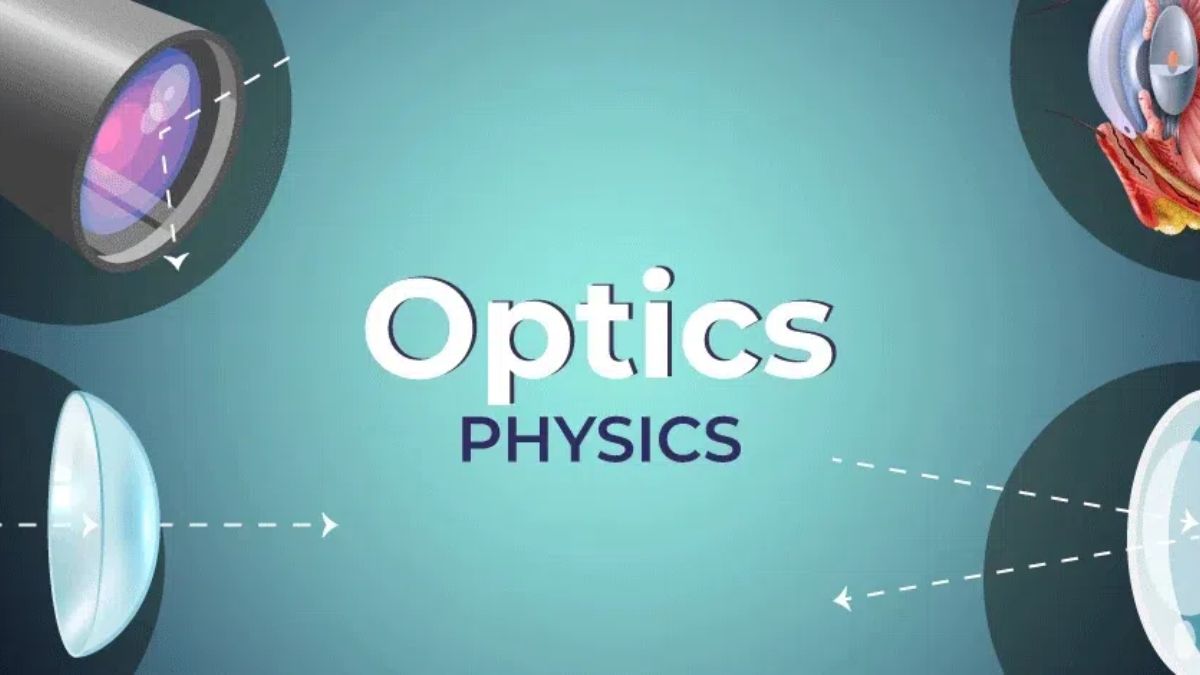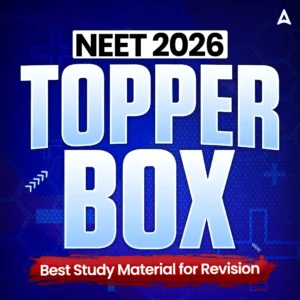The National Eligibility cum Entrance Test is a national level entrance examination conducted by the National Testing Agency at various examination centers across the nation. All the aspirants who are interested in medical career after class 12th must start preparing for the NEET 2026 exam by reading all the important topics mentioned in the NEET Syllabus 2026. One such important chapter that is a crucial part of the NEET Physics Syllabus 2026 is the Optics Chapter. Therefore, in this article below, we have added the NEET Physics MCQs for Optics Chapter making them accessible by all the aspirants preparing for the NEET Exam 2026.
NEET Physics MCQs for Optics Chapter
Optics is one of the most fascinating and high-weightage chapters in the NEET Physics syllabus. It deals with the study of light, its properties, and its interaction with different media. This chapter covers two major parts – Ray Optics (Geometrical Optics) and Wave Optics. Many NEET aspirants find this chapter both conceptual and numerical, making MCQ practice extremely crucial for success.
The NEET Optics chapter covers Ray Optics and Wave Optics, focusing on how light behaves and its applications in instruments. Key topics in Ray Optics include reflection and refraction with plane and spherical mirrors, lenses, optical instruments like the human eye, microscopes, and telescopes, and the principles of phenomena like dispersion. Wave Optics explores light as a wave, covering concepts like Huygens’ principle, interference, diffraction, and polarization.
Key Topics in Optics for NEET
Before trying to solve the NEET Physics MCQs for Optics Chapter, all the aspirants must try to understand all the important topics covered in this chapter. Therefore, we have added a list of all the important topics below, to give students a quick recap of the chapter.
1. Ray Optics (Geometrical Optics)
- Reflection of Light
- Spherical Mirrors: Mirror Formula, Magnification
- Refraction of Light, Snell’s Law
- Total Internal Reflection (TIR) and Its Applications (e.g., Optical Fibers)
- Lenses: Lens Formula, Magnification, Combination of Lenses
- Prism: Deviation, Minimum Deviation Condition
- Optical Instruments: Microscope, Telescope, Human Eye, Defects of Vision
2. Wave Optics
- Huygens’ Principle and Wavefronts
- Interference of Light (Young’s Double Slit Experiment – YDSE)
- Diffraction of Light (Single Slit Diffraction)
- Polarization of Light and Its Applications
Importance of Solving NEET Physics MCQs for Optics Chapter
Solving NEET Physics MCQs for Optics Chapter is important for the aspirants as this not only helps them with the exam preparation but also with the necessary confidence. Below we have detailed some of the factors that detail the importance of solving NEET Physics MCQs for Optics Chapter:
- Strengthens Conceptual Clarity: Optics requires a strong grasp of formulas like mirror equation, lens equation, and interference conditions.
- Improves Speed & Accuracy: NEET questions are usually direct but calculation-based; practice helps you solve faster.
- Exam-Oriented Preparation: Questions are often based on standard derivations and formulae from NCERT.
- Boosts Visualization Skills: Ray diagrams and wavefront diagrams are frequently asked, and practice makes them easier to recall during the exam.
- Covers Application-Based Problems: Many questions involve real-life applications like optical instruments and TIR.
| NEET Physics Chapters | MCQ Link |
|---|---|
| Physics and Measurement | Click Here |
| Kinematics | Click Here |
| Laws of Motion | Click Here |
| Work, Energy, and Power | Click Here |
| Rotational Motion | Click Here |
| Gravitation | Click Here |
| Properties of Solids and Liquids | Click Here |
| Thermodynamics | Click Here |
| Kinetic Theory of Gases | Click Here |
| Oscillation and Waves | Click Here |
| Electrostatics | Click Here |
| Current Electricity | Click Here |
| Magnetic Effects of Current and Magnetism | Click Here |
| Electromagnetic Induction and Alternating Currents | Click Here |
NEET Physics MCQs on Optics Chapter
The aspirants who are looking forward to appear for the NEET Exam must start preparing for the exam by solving more and more Optics MCQs as listed below:
Question 1: A concave mirror forms an image of a real object at a distance of 30 cm in front of it. If the focal length of the mirror is 20 cm, the object distance is:
(a) 12 cm
(b) 60 cm
(c) 30 cm
(d) 40 cm
Answer: (b) 60 cm
Question 2: The refractive index of the material of a prism is √3 and its refracting angle is 60°. The angle of minimum deviation is:
(a) 30°
(b) 45°
(c) 60°
(d) 75°
Answer: (a) 30°
Question 3: In Young’s Double Slit Experiment, if the slit separation is doubled, the fringe width will become:
(a) Half
(b) Double
(c) Four times
(d) Unchanged
Answer: (a) Half
Question 4: Critical angle for a medium is 30°. The refractive index of the medium is:
(a) 2
(b) √3
(c) 1.732
(d) 0.5
Answer: (a) 2
Question 5: Which of the following phenomena proves the wave nature of light?
(a) Photoelectric effect
(b) Reflection
(c) Refraction
(d) Interference
Answer: (d) Interference
Question 6: In a compound microscope, the magnifying power can be increased by:
(a) Decreasing focal length of objective
(b) Increasing focal length of objective
(c) Using a convex mirror as objective
(d) Decreasing focal length of eyepiece
Answer: (a) Decreasing focal length of objective
Question 7: A convex lens of focal length 10 cm is placed in contact with another convex lens of focal length 20 cm. The effective focal length is:
(a) 6.67 cm
(b) 30 cm
(c) 15 cm
(d) 20 cm
Answer: (c) 6.67 cm
Question 8: If the wavelength of light used in Young’s double slit experiment is increased, the fringe width will:
(a) Decrease
(b) Increase
(c) Remain unchanged
(d) First decrease then increase
Answer: (b) Increase
Question 9: The power of a convex lens is +5 D. Its focal length is:
(a) 5 m
(b) 0.5 m
(c) 20 cm
(d) 10 cm
Answer: (b) 0.2 m (or 20 cm)
Question 10: In a single slit diffraction pattern, if the slit width is reduced, the central maximum becomes:
(a) Narrower
(b) Broader
(c) Unchanged
(d) Darker
Answer: (b) Broader
Question 11: The phenomenon used in optical fibers is:
(a) Reflection
(b) Refraction
(c) Diffraction
(d) Total Internal Reflection
Answer: (d) Total Internal Reflection
Question 12: The focal length of a concave mirror is 20 cm. For an object placed at 10 cm from the mirror, the image formed is:
(a) Real, inverted, magnified
(b) Real, erect, diminished
(c) Virtual, erect, magnified
(d) Virtual, inverted, magnified
Answer: (c) Virtual, erect, magnified
Question 13: The resolving power of a microscope increases when:
(a) Wavelength of light used increases
(b) Aperture decreases
(c) Wavelength of light used decreases
(d) None of these
Answer: (c) Wavelength of light used decreases
Question 14: When unpolarized light passes through a polarizer, the intensity of transmitted light is:
(a) Doubled
(b) Halved
(c) Reduced to one-fourth
(d) Unchanged
Answer: (b) Halved
Question 15: Which of the following statements is correct?
(a) In refraction, frequency changes but wavelength remains constant
(b) In refraction, wavelength changes but frequency remains constant
(c) Both wavelength and frequency change
(d) Neither wavelength nor frequency change
Answer: (b) Wavelength changes but frequency remains constant
Year Wise NEET Physics MCQs for Optics Chapter
In the table listed below, we have added the year wise NEET Physics MCQs for Optics Chapter so that all the students can start preparing accordingly. Click on the links below:
| Year Wise NEET Physics MCQs for Optics Chapter | |
| Year | Links |
| 2014 | Click Here |
| 2015 | Click Here |
| 2016 | Click Here |
| 2017 | Click Here |
| 2018 | Click Here |









 NEET Preparation Strategy 2026: Detailed...
NEET Preparation Strategy 2026: Detailed...
 Free NEET Sample Papers 2026 PDF | Downl...
Free NEET Sample Papers 2026 PDF | Downl...
 Salt Analysis NEET Notes, Check Importan...
Salt Analysis NEET Notes, Check Importan...









